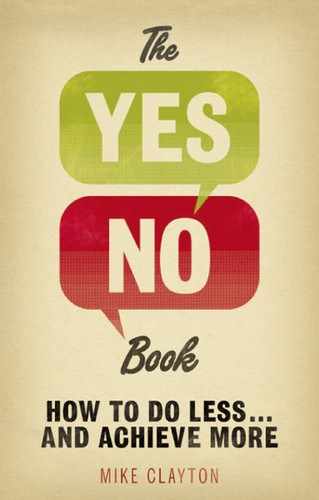CHAPTER 2
Bury the Gopher
There is no doubt that Gophers are a nuisance. So you need to bury them and keep them out of your way, then you can focus on what is important and feel more in control. Let’s look at the why and the how of Gopher-burying, and then find some practical questions to ask that will help you to know when and how to bury your inner Gopher.
Why bury the Gopher?
There are lots of good reasons to bury your inner Gopher. Let’s take a look at some of them.
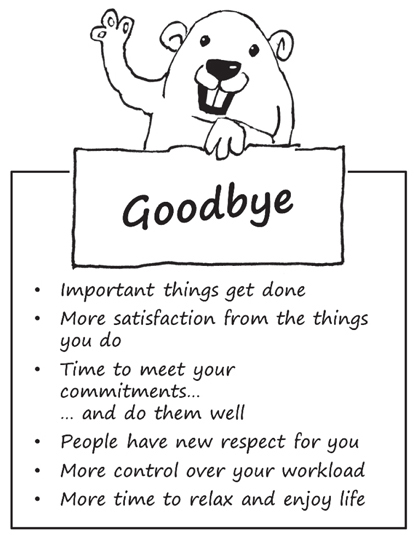
Important things get done
The first thing you gain when you bury your Gopher is the time you need to do the things that matter. You will start to notice that the important things get done and, as a result, you will feel like you are starting to make progress with your goals, your projects, your career, and your life.
More satisfaction from the things you do
When you have the time to beaver away at the important things, two things will happen. The first is that you will get a lot of satisfaction from completing them. This is not just the knowledge that something important is done – which is a great satisfaction – but also the knowledge that you have done it well and given it the time and attention it deserves.
The second is that you will get satisfaction from doing the things you do because you have chosen to do them. When your mind is not distracted by Gopher-level activities, you can focus on what really matters and be able to enjoy doing it – whatever it is.
Time to meet your commitments…
… and do them well
When you bury your Gopher, you will only take on commitments to other people that you choose to take on. And, because there will be fewer of them, you will have more time for them, and feel less pressured by them. They will seem less of a chore and, because you have more time for them, you will find that the quality of your work on them will improve.
People have new respect for you
The increasing quality of your work is one reason why people will have a new respect for you. But by far the greater reason is that you are no longer a yes-woman or yes-man, saying ‘yes’ to everything and therefore truly committing to nothing. Now, rather than being the doormat, you are the door, blocking the way to requests that do not suit you.
When you say ‘yes’ now, you are saying ‘yes’ for a good reason. Your choices are strategic: you are thinking about what is important for you, for your team, and for the organisation you work for. And you are investing your time wisely, which will deliver a good return.
More control over your workload
Having fewer things to do, having the time to focus on what’s important, and feeling able to say ‘no’ to meaningless tasks, will give you more control of how you use your time. You can now schedule when to tackle your jobs with more confidence, and start to feel in control of your workload. You can start to balance how much you set out to achieve with the time you choose to make available. In that time you can beaver away at making a difference, and get more done.
More time to relax and enjoy life
Feeling that you aren’t in control leads to stress. Your inner Gopher is a stress-making behaviour pattern. When you bury it, stress will start to fall away, because you – not it – are in control.
The added benefit is that you will now have more time to relax and enjoy your life. Your life will become what you choose it to be; not what others specify and you accede to, through the actions of your inner Gopher.
How to bury the Gopher
This section is not yet about how to say ‘no’. You’ll need to be a little patient and wait for the next chapter, Chapter 3, to start learning that important skill.
First, before you can say ‘no’ confidently, you have to learn how to bury your inner Gopher: how to conquer your urges to go for this and go for that, without thinking. This section is about changing the way you think, fundamentally, about your time. There are three steps to take, and some exercises that will help you along the way.
Step 1: Focus on the things you can control or influence
The control paradox
There are some things in life that you can control – and others that you can’t. Spending your time going for this and going for that, in an attempt to control the things you cannot control is futile. Yet we often do, without thinking.
The paradox is that the more we focus on the things we want to control, the more aware we become that we are failing, and the greater the need we feel to control them. There is no end to this cycle of increasingly more futile attempts to wrestle control.
What you have to do is break the cycle. You can do this by changing your focus on to the things that you can control. When you do this, your actions have a real effect on the world – your job, your family or your aspirations. This will give you a sense of achievement and well-being that leads to a far more positive cycle.
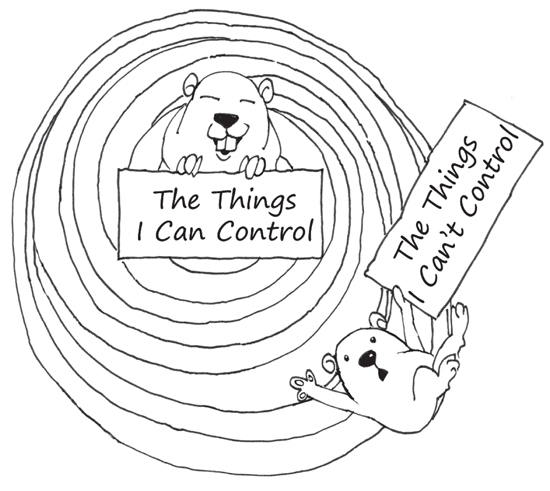
Step 2: Consciously slow yourself down
Slow down
There is a proverb: ‘more haste: less speed’. When you get yourself into a busy-busy, got-to-go-for-it mindset, it is hard to be effective in what you do. This leads to mistakes and wasted effort that actually hold you back.
When you slow down deliberately, your responses and your work are more considered and careful. This means that you can get more done, to a higher standard. So make a conscious effort to be deliberate and to take the important things more slowly.
Step 3: Have the flexibility to say ‘yes’ to exciting opportunities
Embrace serendipity
Serendipity (n): ‘an unexpected discovery, made by chance’.
Focus and a determination that you can say ‘no’ when it is the right thing to say, are important, but never let your focus become tunnel vision. If you do, you will miss the wider world of beauty and the opportunities that surround you.
When you know not just what you are focusing on but also why it is important, then you will be able to spot the opportunities that will give you more of what you want, more easily.
Burying the Gopher will give you more space in your life to seize opportunities and embrace the joys of the moment. Make a conscious effort to look around you and see what is out there, just waiting for you to take advantage of it.
Exercises to help you bury the Gopher
Burying your inner Gopher means becoming expert at taking time for yourself and what is important to you. Here are six ways you can start to hone that skill.
Evaluation
Most of us have a To Do list somewhere – in our notebooks, on a scrap of paper, electronically, or just in our heads. Examine it critically.
First, look for the longest-range project that you have on your list. If there is nothing that contributes to a project that lasts as long as a year, then that should tell you something! But let’s say you have a couple of tasks that are part of a project that will only be complete in two years. Two years now becomes your time frame.
Now look at the list and mentally or physically cross off all of the things that really do not matter. These are things that you know you ought to say ‘no’ to; that you ought not to take on. To help you, you may want to consider their importance in the scale of your time frame. In our example, how important will they seem two years from now?
Finally, shift your perspective. If your time frame is two years, ask yourself, ‘What if I only had two years to live?’ Would this be a ‘yes’ task or a ‘no’ task?
Savouring your experiences
Pick one experience each day and experience it one hundred per cent. Savour every last moment of it. One day it may be your lunch; another, a conversation with a friend or colleague. It may be a work task, or a chore at home, like washing up, gardening or mending a tap. It may be something as simple as drinking a cup of tea. Take the time to notice all of the details. Do it steadily, with no rush to complete it. Savour it for what it is. When you start to experience every last gram of experience, the tasks you choose to take on will seem more fulfilling, and meaningless tasks will start to seem more of a waste of your valuable time.
Thinking time
Once a week, give yourself at least half an hour of high-quality head-space. Take time to think about anything and nothing. Find a park bench, a comfy sofa, or a pleasant café that is not intrusively noisy. Pick a time when it is not frequented by friends and colleagues. Go there alone and take nothing except a pen and paper. Get yourself a drink and spend your time thinking.
If something is on your mind, turn it over and see what’s underneath. If you are working on a project or initiative at home or at work, think through what might be coming up. If there’s nothing much on your mind, let it wander. Often, this is the most valuable time of your week, so don’t waste it by being a Gopher and trying to do something.
A useful tip is to set yourself a question before you take yourself off for your thinking time. Perhaps, ‘What am I missing?’ or ‘What next?’ Maybe ‘How can I do this?’ or ‘What can I learn from that?’
Giving time
How about giving somebody some of your time? What could be better training to repress the over-eager Gopher than to stop and give? Think of someone important in your life – a colleague, a friend, a family member – and set a time with them that you can spend together. Then give them your absolute and complete attention. Listen to them, respond to their agenda, do what they want to do. It is their time, not yours.
Go for a walk
Nothing recharges your batteries and relieves stress as simply, easily and time/effort-effectively as getting up and going for a walk. Energy flows, blood flows, your parasympathetic nervous system is revived, your breathing and posture improve, and your mind starts to access the unconscious thoughts that have been going on over the last hours or even days.
Movement is a therapy, but it also exercises your Gopher’s need to get up and go for it, without going for something you should be saying ‘no’ to.
Holidays and breaks
A classic Gopher problem is an inability to allow itself a proper break – or, when compelled to take a break, to properly enjoy it. So consult your loved ones and book a holiday. Don’t put it off with the expectation that you will grab a last-minute holiday. Sit down and plan a real break that you will enjoy. Clear your diary – ideally taking an extra day off work on the day before your break starts – and book something good.
Four questions for Gophers
One of the dangers that faces a Gopher mentality is the never-ending To Do list. No matter how well you do, your inner Gopher will find more things to keep adding to the list and, therefore, more things to go for.
You may not be able to bury the Gopher straight away, but let’s start by putting it in its place. This means addressing the To Do list that keeps on growing. You can do this by asking four crucial questions whenever you feel your inner Gopher is pulling you to go for it.
Question 1: ‘What if I don’t do it?’
This question is about consequences. What can you realistically expect to happen if you do not go for it? To what extent are the consequences acceptable to you?
Get into the habit of asking this question, and you may be surprised about how often the answer is ‘nothing’ or, at least, ‘nothing much’. Often this will apply to the tasks you have at the bottom of your To Do list: the ones that get copied from one To Do list to the next, when you’ve completed all but the last few things. You feel like you should go for them – in fact you feel guilty that you haven’t. But you’ve been putting them off for days, weeks, or even months.
So, if you do find the answer is ‘nothing’ or ‘nothing much’, then cross those things off your list and savour the sense of release you get from having decided that you won’t go for it after all.
If you have trouble with this, try taking it off your To Do list, and transferring it to a new list, on a new sheet of paper – a To Don’t list. Keep it somewhere safe, but out of the way.
Example
Martin and Jean moved to a new house and immediately made a list of small improvements and jobs to do. One month later, all but five were done. Six months later, Martin still looked at the list every weekend but found excuses not to tackle any of the jobs. There were still five things on the list. Finally, he realised that throwing the list away was not going to make him any less likely to do the jobs, but it would stop him fretting about them every weekend.
Notice that you may find cases when you ask ‘What if I don’t do it?’ and you get an answer like: ‘I’d be fine with it – my boss will be furious.’ What does this mean?
It means that you may not be looking far enough ahead. Perhaps what you should have thought was: ‘My boss will be furious – it could affect my appraisal – my career could be harmed.’ If you are fine with that, then don’t do it, but burying your inner Gopher must not compromise your long-term priorities. If you realise that this isn’t the career for you, it’s time to stop going for this career. Otherwise, burying your inner Gopher is not a sound excuse for not doing the jobs at work that you don’t like.
Let’s assume you must do it. What next?
Question 2: ‘What if I only do part of it?’
Once again, look at the consequences of splitting the task up, or of doing it to a different standard from the one you might carelessly assume is needed. Can you make the task smaller, to free up time for other things?
Assess the completion criteria objectively. Think about the people who will evaluate what you do and ask yourself – and them: ‘What does “done” need to look like?’ We often set or expect standards without careful thought.
Sometimes ‘good enough’ is not what you want: you want ‘the best possible’. But in most circumstances, anything better than good enough is a waste of effort that will diminish your capacity to do everything you need. Understand what you are doing it for, and limit your ambition to go for the best to the times when the best will make a difference. All other times, deliver ‘done’ to meet the needs of the situation.
Example
Victoria had to produce a management report every month. It was a 20-page document with lots of detailed analysis. One month she was extremely busy with a critical project and found herself short of time. She simplified the report and presented five pages of graphs and tables, each with a headline describing the key things that it illustrated. It took her a fraction of the time. When they received it, all of the directors were highly complimentary about the new format she had developed and urged her to keep that format.
You won’t always be able to diminish the task at hand, so what next?
Question 3: ‘What if I do it later?’
Don’t just go for it without assessing when it is needed and when would be the best time for you to attend to it. ‘Right, I’ll do it straight away’ sounds positive and enthusiastic, and can get you into all sorts of time-management troubles. How about: ‘Right, leave it with me, I’ll do it in good time for the deadline.’
When you understand time priorities and can schedule tasks to suit you, you gain control and give things the time they need, without feeling rushed. They don’t interfere with what you are doing now, so your work also becomes more efficient and effective.
Another source of pressure from your inner Gopher to go for it are all those aspirational tasks and projects on your To Do list. You want to get started on all of them, but you’ve been putting them off because you don’t feel like you have enough time. This can cause stress – a tension between wanting to go for it and knowing the time is not right.
The solution is to take those things off your To Do list. They don’t belong on your To Don’t list, so you need a new list: a Will Do list. Your Will Do list is the first step in planning how and when you will do something. It contains a clear description of what you plan to do and two essential dates: a start date – when you will start work on getting it done; and a finish date – when you propose to have it completed.
What this does is turn a pesky To Do item into the start of a plan. By defining a start and end date, you have turned it into a project – maybe it is just a mini-project, but it gives you a recognition that this needs thought and sets a time to do it. Now it isn’t a To Do item prodding away at your inner Gopher, it’s a plan. Now you have taken control and you will find a great deal less stress associated with it.
Example
Gregor was a highly productive salesperson and kept a full To Do list. But there were three big items on it that seemed to get bumped from one To Do list to the next. These were great ideas, but his busy schedule did not permit him to tackle them. Whenever he put them on to a new To Do list, he felt miserable. But he certainly didn’t want to abandon these great initiatives to a To Don’t list. So he started a new page in his notebook for the first one, wrote it at the top and, on the next line, wrote ‘Plan for completion by the end of November’. For the second, he blocked out some time in his diary in two days’ time, to get started. And for the third, he replaced the words ‘new sales initiative’ with ‘Speak to Carolyn about a possible new sales initiative’. Now he felt he had made some progress on all three.
You may not be able to reschedule it until later. What next?
Question 4: ‘What if someone else does it?’
Does it have to be you? Is there really nobody else who could do it? Part of the mentality of many Gophers is the belief that:
- ‘I’m the only one who can do this’ or
- ‘Others could do it – but not as well’.
Some even fear:
- ‘If I don’t do it, someone else will get the credit’.
Well, you are rarely the only person who could do a good job, even if others would do it differently. Sometimes, they will do it better, but even if they don’t, if they never get a chance to learn, then you’ll be stuck in an endless cycle. So, you worry about the credit. Don’t. If you can identify the right person for the job in a few minutes, then that is a capability people will value.
Sometimes, the answer to this question is delegation: giving your task to someone else to do for you. Sometimes it is about abdication: recognising that it is not important enough to you for you to do it and leaving it for someone else to pick up, if it is important enough to them.
Sometimes, however, you will realise you do need to do it; you need to do all of it; you need to do it now; and only you can do it. Now your inner Gopher has lost control. You are going to do it, not because the Gopher made you, but because you decided that it is the right thing to do.
Top tip
Make yourself small cards – or download one from www.theyesnobook.co.uk – with the four questions for Gophers on them. Put the cards in your pockets and your bags, so you always have one ready to hand, wherever you are.
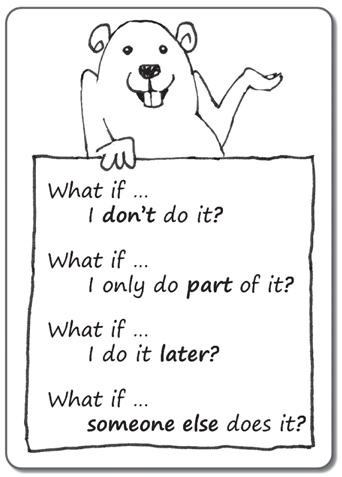
A new kind of Gopher
These four questions may not be enough to bury your inner Gopher forever, but they will at least enable you to swap it for a new one. In the next chapter you will start to learn how to say ‘no’, but for now, you have four questions that will allow you to unleash your Selective Gopher. The Selective Gopher is you, in charge of making careful decisions about what you go for and what you don’t.
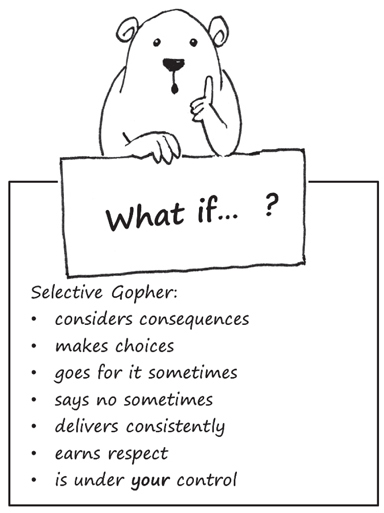
Yes/No in an instant
There are many good reasons to bury your inner Gopher. To do so, you need to get comfortable with saying no. Start to focus on the things you can control, slow yourself down, and stay flexible so that you can embrace new opportunities. When you feel tempted to go for it, ask yourself the four questions.
| Yes/No: | Have you found a change you can make, to start to bury your inner Gopher? |
| Yes/No: | Do you have the four questions for Gophers ready to hand? |
| Yes/No: | Are you ready to start saying ‘no’? |
